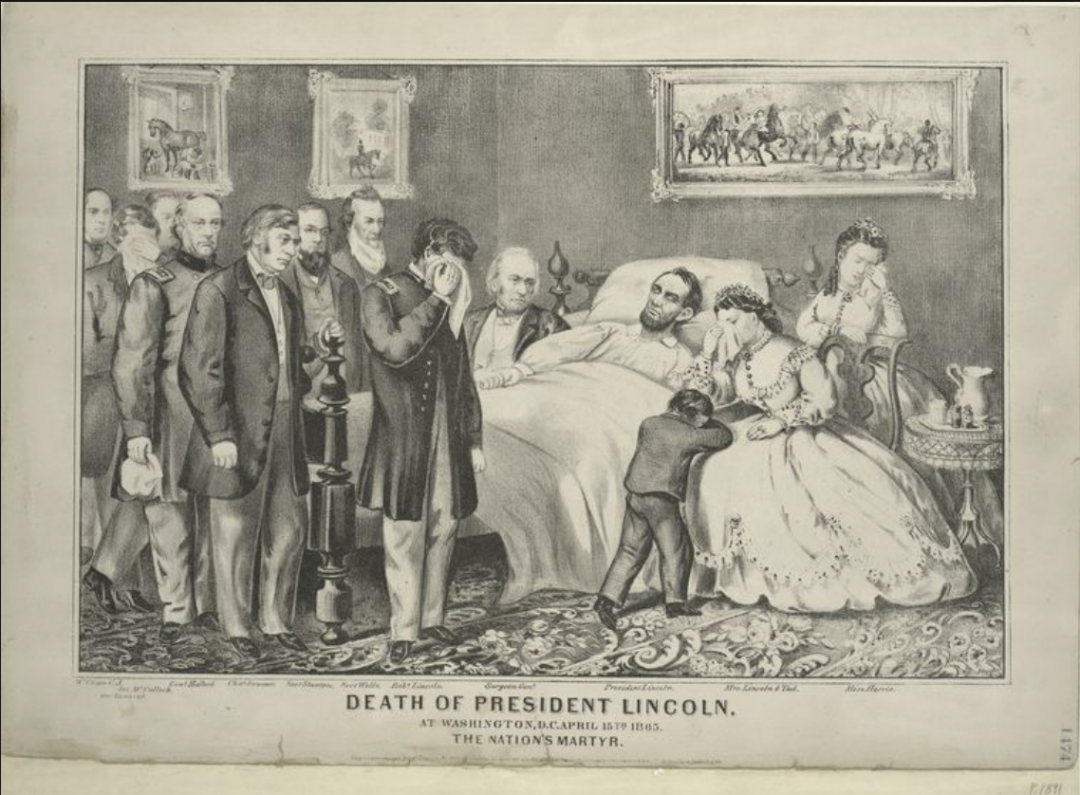The illustration “Death of President Lincoln” by Currier and Ives created in 1865 depicts the aftermath of one of the most significant events in American history, the assassination of Abraham Lincoln, the 16th president of the United States. The illustration shows Lincoln on his deathbed, surrounded by his family and friends, all mourning the passing of their loved one. The anguish apparent on the face of each individual in the image indicates how loved and respected Lincoln was. The caption at the bottom of the illustration reads “the nation’s martyr”, a title that encapsulates the legacy Lincoln left and the impact his presidency had on the country.
Elected in 1860, Abraham Lincoln became the first Republican to win the presidency. Outraged by the idea of an anti-slavery Republican taking office, southerners believed Lincoln threatened their way of life. In protest of his election, they decided to secede from the union, forming the confederate states of America. Their succession was the catalyst that led to the American Civil War, as they challenged the union in what they claimed was an “effort to defend states’ rights against the federal government” when their true motive could be seen as protecting the institution of slavery[1]. Lincoln used his first inaugural address in 1861 to acknowledge the concerns of the South and explain that his true intentions were not to strip Southerners of their rights but rather to find peaceful solutions to help end their apprehension towards him. He wanted to reiterate to southerners that he had “no purpose, directly or indirectly, to interfere with the institution of slavery in the States where it exists,” admitting that neither he nor the federal government had the power to do so[2]. By the end of his address, it became clear that Lincoln was a man who valued not only freedom but the upkeeping of democracy and the constitution that the nation was founded on. But the Southern states dismissed his warning of the dangers that would come from seceding from the union as they remained distrustful and resisted any efforts made by Lincoln.
Ultimately, the opposition to Lincoln’s presidency from Southerners led to his assassination in 1865. While attending a play at Ford’s Theatre in Washington, D.C., Lincoln was shot by actor and known Confederate supporter John Wilkes Booth[3]. Before fleeing the scene, Booth declared “sic semper tyrannis”, a Latin phrase alluding to the death of a tyrant. This statement many historians believe was Booth’s way of announcing that he had avenged the South[4]. The death of President Lincoln sent shockwaves through the nation as he was the first president to be assassinated while in office. The country, similar to the individuals seen in the illustration, was left distraught, mourning the loss of their fearless leader. As mentioned in Jordan’s historical account of Lincoln’s assassination, “the fact that grief so universal and so sincere was awakened by his death has become a matter of history. This common and spontaneous tribute of tears will aid future generations in making up their verdict concerning his character”[5]. Many saw Lincoln as a symbol of hope for a unified nation and prosperous future post-Civil War. From his death came the title of “the nation’s martyr”, one that is still seen today as the nation recounts the life of Abraham Lincoln as a prosperous one. A leader who died fighting for the preservation of the union and democracy, the one who led the abolition of slavery. All things that can be taken from the despair and sorrow illustrated in the piece Death of President Lincoln.
[1] David Shi, America: A Narrative History, Brief 12th edition, volume 1, ISBN ISBN 978-0393882537.
[2] Abraham Lincoln. Abraham Lincoln papers: Series 1. General Correspondence. -1916: Abraham Lincoln, March 1861 First Inaugural Address, Final Version. March 1861. Manuscript/Mixed Material. https://www.loc.gov/item/mal0773800/.
[3] Ebenezer Stevens Jordan. Death of Abraham Lincoln. Portland [Me.] Printed by D. Tucker. 1865. https://search.ebscohost.com/login.aspx?direct=true&AuthType=sso&db=edshtl&AN=edshtl.MIU01.009596886&site=eds-live.
[4] Thomas J. Reed. Avenging Lincoln’s Death: The Trial of John Wilkes Booth’s Accomplices. Lanham, Maryland: Fairleigh Dickinson University Press. 2016. https://search.ebscohost.com/login.aspx?direct=true&AuthType=sso&db=e000xna&AN=1087183&site=eds-live.
[5] Ebenezer Stevens Jordan. Death of Abraham Lincoln. Portland [Me.] Printed by D. Tucker. 1865. https://search.ebscohost.com/login.aspx?direct=true&AuthType=sso&db=edshtl&AN=edshtl.MIU01.009596886&site=eds-live.
